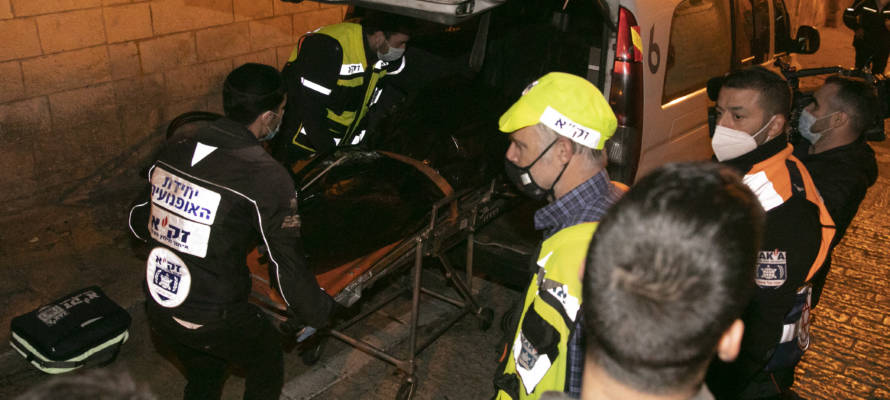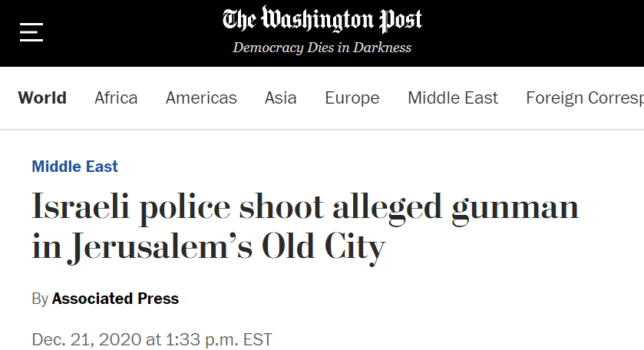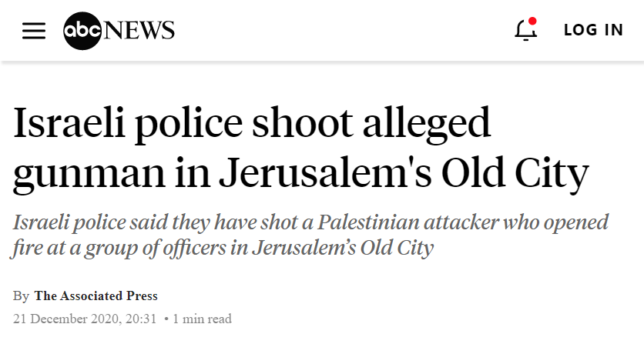
When multiple news outlets described a recent attacker in Jerusalem as an “alleged” shooter despite video evidence of the gunman opening fire, this constitutes a collective failure by the media to report the story accurately.
By Emanuel Miller, Honest Reporting
Anyone who has spent time reading the news understands that developments are often reported in a standardized way, with particular phrases and words such as “alleged” repeatedly occurring.
Sometimes, however, an event is easily verifiable. So, when multiple news outlets including Reuters, Associated Press (AP) and The Washington Post described a recent attacker in Jerusalem as an “alleged” shooter despite video evidence of the gunman opening fire, this constitutes a collective failure by the media to report the story accurately.
First, the facts: In the early hours of Monday morning, a Palestinian opened fire on a group of officers in Jerusalem’s Old City. Video footage of the shooter holding a gun, and firing it, has been widely shared on social media. A clear photograph of the gun was published on Israeli news sites, and walls pockmarked with bullet holes were photographed by local media.
While the question of motive — that is, whether the perpetrator was driven by hate or criminal intent or suffered from mental illness — is subject to police investigation, there is no debating that a shooting took place.
But the AP headline leads readers to believe that the matter is up for dispute: “Israeli police shoot alleged gunman in Jerusalem’s Old City.”
It would be bad enough if the Associated Press alone published this headline. But because AP is one of the world’s largest wire services, many other leading news outlets reprint its content, often verbatim.
Here, for example, is the article on The Washington Post website:

And here’s the same article, and same headline, on Yahoo News:

The piece was republished in plenty of additional well-known media outlets. Here it is on the ABC News website.

This is one of the ways in which media bias becomes so pervasive: The word “alleged” is used even though the incident was captured on video, and despite the fact that a gun, bullet casings and bullet holes were found at the scene. But a single awfully-phrased AP headline framing the event as Israeli police targeting an “alleged” gunman means inaccurate news spreads like wildfire throughout the media.
Spineless “He Said, She Said” Journalism
Beyond the headline, the content of the article is also deeply problematic. It begins not by focusing on the shooting itself but, rather, on the response of the security forces being attacked.
Israeli police said Monday they shot a Palestinian attacker who opened fire at a group of officers in Jerusalem’s Old City.
According to police, the attacker approached a police post near the Lion’s Gate entrance to the Old City and fired with a rudimentary submachine gun known as a “Carlo.”
Notice the phrases, “Israeli police said” and “according to police”. Time and again, Palestinian violence is described in terms of being claimed by Israelis. It’s not a claim. It’s real. Journalism should document the facts, as facts.
Look at the video below. Is there any confusion about what is happening?
This dynamic was likely the root cause of Reuters‘ headline about the same attack:

Credit should be given when due, though: Reuters subsequently updated its headline to the far more accurate, “Gunman shot dead after firing at Israeli police in Jerusalem’s Old City.”
Returning to the AP article, more problems arise in this background paragraph (emphasis added):
“In recent years, lone Palestinian attackers, usually not connected to organized militant groups, have been accused in a string of alleged stabbings, shootings and car rammings against Israeli security forces or Jewish settlers in the West Bank. Palestinians and rights groups often accuse Israeli security forces of using excessive force.”
These attacks were not merely “alleged.” Surely a news organization such as Associated Press has the resources to confirm that at least some of the hundreds of stabbings, shootings and car ramming attacks in recent years in fact occurred, rather than muddy the waters by describing all such attacks as “alleged.”
The role of journalists isn’t to merely repeat claims as to what happened, but to determine what exactly transpired and report the events as accurately as possible. First and foremost, the journalist’s task is to establish the truth. Otherwise, people end up reading this kind of wishy-washy “he said, she said” reporting. In replacing facts with claims, the objective truth is buried.
Journalism can be a complicated business. Establishing facts is not always easy. But the media’s propensity for reporting facts as allegations only serves to blur the lines between narrative and reality, making it possible for the public to doubt that Israelis really are under attack.

No comments:
Post a Comment